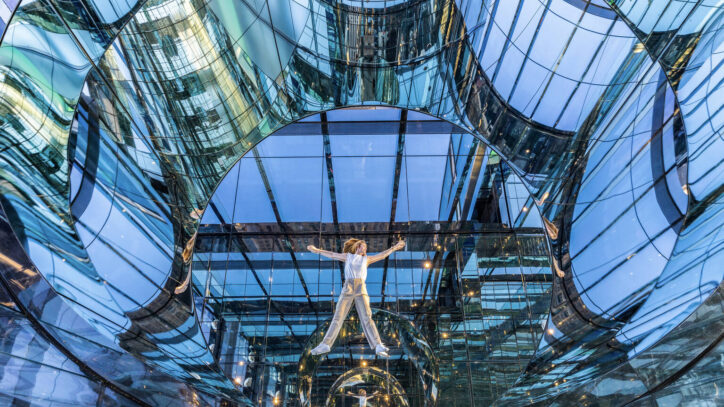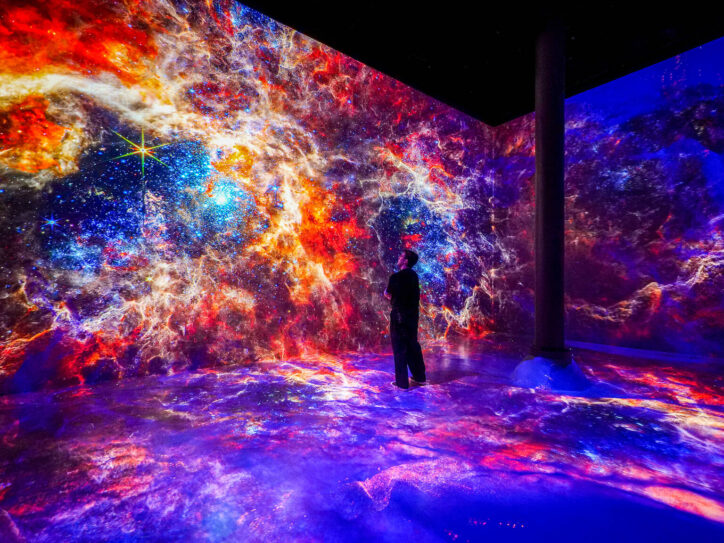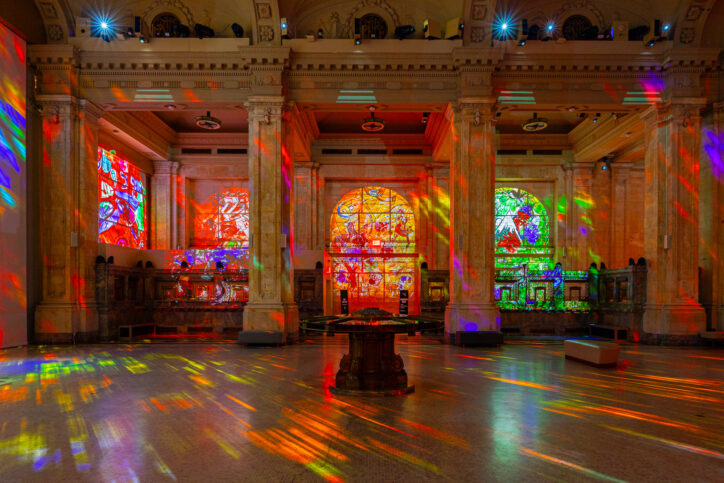Immersive Theatre: Art and Humanity from Sleep No More to A.I.
Immersive theatre has become increasingly prevalent in recent decades; as of this writing, dozens of diverse productions ranging from bubble shows to cocktail parties are all laying claim to the label of “immersive” (with varying degrees of legitimacy) in New York City alone.
A trendy but complex form that aims to break down the traditional separation between performer and audience, the modern popularity of the form in the United States owes much to the breakout work of British theatre company Punchdrunk. Most notably, their flagship production, Sleep No More, premiered in London in 2003 and has been a permanent and deeply influential fixture of the New York theatre landscape since 2011.
Today, theatre artists eagerly work to create even more engrossing environments by incorporating emerging technologies like virtual and augmented reality — and even artificial intelligence.
While this may sound futuristic, the fundamentals of immersive theatre can be traced as far back as Ancient Rome.

What Immersive Theatre Is…and Isn’t
Essentially, immersive theater aims to fully immerse the audience in the world of the play. Often, this can involve a unique, adapted location (site-specific theatre) and interactivity with the environment as well as the performers (although I hasten to add that “interactive theatre” is not synonymous with “immersive theatre”).
At its best, immersive theatre stimulates all the senses through detailed design, opportunities for interaction, and an emphasis on each person having a unique, personalized experience.
However, as immersive theatre has become a popular buzzword, the term is sometimes applied rather loosely to conventional productions that make only superficial gestures toward “immersion.” For example, many immersive artists argue that for a production to be truly immersive, the audience must be active participants in shaping their own journey through the imagined world, not just passive observers of a pre-determined narrative.
Sleep No More is a well-known contemporary example. This site-specific performance transforms a multi-floor warehouse into a detailed film noir world inspired by Shakespeare’s Macbeth, the films of Alfred Hitchcock, and the 1697 Paisley witch trials.
The elaborate set design transports the audience into the 1930s noir setting, stimulating the senses through richly detailed rooms, theatrical lighting, and masterful sound design.
Each person also shapes their personalized experience instead of passively watching a pre-determined story; given Venetian-style masks to wear, audience members are free to roam the elaborate environment at their own pace, interacting with props and environments, as wordless scenes unfold simultaneously in different rooms and spaces. The masks both allow for intimate proximity to the performers and encourage the shedding of inhibitions to engage in the imagined world fully.
Sleep No More fully embodies key principles of immersive theatre and exemplifies how it can provide a participatory, sensory, and transformational artistic experience. Yet, although their work arguably brought immersive theatre into the modern mainstream, Punchdrunk hardly invented the form.

Centuries of Innovation
The desire to immerse audiences within imaginative worlds is an innate part of theatrical arts. As such, the contemporary form of immersive theatre has roots stretching back thousands of years.
The origins can be seen in the festivals, spectacles, and site-specific performances of the Ancient Greek and Roman eras. Outdoor amphitheaters allowed large audiences to surround performances on all sides, while rituals integrated the crowd into the experience. Actors would break the fourth wall to address spectators directly.
In the Middle Ages, productions continued engaging audiences in intimate ways. Mystery plays based on Bible stories were performed on moving wagons that traveled through villages and towns. The audience followed along with the procession, interacting with characters and spectacles. Elements like music, dance, and architecture were united in immersive medieval theatre.
Centuries later, artists like opera composer (and outspoken antisemite) Richard Wagner applied German philosopher K.F.E. Trahndorff’s conception of a “total work of art” (Gesamtkunstwerk), a work that synthesizes, unites, or embraces all or many art forms (for example, music, drama, visual arts, and architecture). Wagner’s Bayreuth Festspielhaus opera house (based on an unrealized project by architect Gottfried Semper, without Semper’s permission) incorporated novel design elements intended to transport audiences more seamlessly into the mythic worlds of his operas.
In the 1920s, theatre visionaries like Konstantin Stanislavski and Bertolt Brecht explored breaking down the division between actor and audience. Antonin Artaud advocated for a “Theatre of Cruelty” that assaulted the senses to shock viewers out of complacency.
Experimentation with environmental and promenade theatre accelerated in the 1960s counterculture. The Living Theatre used “audience immersion” in pieces like Paradise Now, blurring the lines between spectator and performer. In Sleep No More, the mobile audience’s agency over their individual experience recalls the concepts of “happenings,” or situational performance art, and immersive art installations in the late 20th century.
While employing 21st-century technology and design, today’s immersive productions build on these historical foundations, established over millennia. The fundamentals established centuries ago continue to shape innovations in the ever-evolving art of immersive theatre — innovations like virtual and augmented reality.

Augmenting Reality
As immersive theatre has evolved, advanced technologies like virtual reality (VR) and augmented reality (AR) have allowed artists to realize immersion in radical new ways.
VR refers to computer-generated 3D environments that viewers can interact with and explore, often using a headset and hand controllers (for example, Oculus Quest headsets). VR allows each audience member to freely move through a responsive world as an active participant.
Innovative projects like the Chinese production The Dream of the Red Chamber merge digital and live performance in groundbreaking ways, with users journeying through digitally rendered scenes.
Closer to home, Dream Adoption Society’s recent project The Books of Jacob, presented this year at La MaMa Experimental Theatre Club in New York, created a hybrid theatre and virtual reality experience exploring the historical events surrounding Jacob Frank, a man who claimed to be the reincarnation of the self-proclaimed messiah Sabbatai Zevi, and delved into the ideas of his transformative religious movement in 18th-century Europe.
I had the pleasure of attending a performance of The Books of Jacob and was especially impressed by how effectively the piece built connective tissue between the intricate digital world intermingling with and defamiliarizing the real one and the limits of human consciousness, contrasted with the unlimited perspective one imagines a god would possess — an effect accomplished and communicated entirely through the use of virtual and augmented reality technology.
As these technologies advance, theatre will continue to utilize them to reimagine the potential of storytelling. However, while technology can empower new artistic possibilities, the need for human creativity to remain at the core is more important than ever.
This brings us to A.I.

A.I. “Art:” At What Cost?
A.I.’s use in the realm of creative arts has been one of this year’s hottest topics, and for good reason. The nascent technology stands to comprehensively upend many long-standing norms, both creative and otherwise, and both online and off.
When it comes to art, the news isn’t all bad.
One notable example in the visual arts field is Unsupervised, Refik Anadol’s monumental installation currently on view (and recently acquired as part of the permanent collection) at The Museum of Modern Art. Part of Anadol’s ongoing project exploring data aesthetics based on collective visual memories, this piece uses machine learning to create evolving dreamlike A.I.-based abstract hallucinations on a massive LED screen, based on the machine’s unsupervised learning of the Museum’s collection data.
While the piece has divided critics, Lloyd Wise, writing in Artforum, praised it as “spellbinding.” Familiar motifs from the modernist tradition effloresce, hybridize, and vanish: A blossoming of Fauvist color transforms into allover patterning; a biomechanical shape attenuates into graphic registrations on a printed page; a loose grid melts into Cubist planes.”
As Anadol’s algorithmic creations are derived from existing works and dreamed by a machine, it may be difficult to call them truly “original.” However, since the hallucinations themselves arguably constitute the point of the piece, and as artists frequently use process and material as part of their message, it is certainly possible to argue that Unsupervised is a valid piece of A.I. art. In fact, I made a very similar argument in favor of the A.I.-generated animated sitcom spoof Nothing, Forever on this very blog.
This type of argument in favor of Anadol’s work is bolstered by the fact that the A.I. is trained only on art from MoMA’s collection, which can be viewed within the same building, and which in some cases are so famous as to be considered part of the zeitgeist. Additionally, Anadol’s machine hallucinations alter the works to the point of being unrecognizably abstract, and repurpose them for a new expression or meaning, similar to a collage.
Can we really argue that Warhol’s Campbell’s Soup Cans, for example, itself derived from previously-existing commercial imagery, is off-limits for abstracted transformative use? Certainly not.
On the other hand, I don’t believe I could mount a similar defense of theatre artist Annie Dorsen’s recent Prometheus, Firebringer — and, as it happens, Dorsen herself agrees.
Presented by Theater for a New Audience this year at The Polonsky Center in Brooklyn, Dorsen’s piece used GPT-3.5 to fill in a lost fragment of Aeschylus’ Prometheus trilogy, which was then delivered to the audience by large, robotic masks. Her goal was to explore the relationship between technology and power.
Since creating the piece, however, Dorsen went on to write in American Theatre about the dangers of what she called “A.I. intoxication,” and expressed ambivalence about having used A.I. tools — even with the intention of criticizing the technology.
“The technologies changed,” Dorsen explained in the article, “and so did the economic and political environment in which those technologies developed. As the downsides to our increasingly mediated world become more apparent, working with A.I. no longer seems quite as defensible as it once did.” She continued, “I’ve become more and more concerned about the role artists are playing in popularizing these technologies.”
“These technologies were not designed to assist artists,” Dorsen wrote, “they were designed to replace them.”
As a theatrical artist myself, I can relate to Dorsen’s evolution. In fact, it even mirrors my own; I used ChatGPT to help create a huge quantity of faux-Shakespearean written content to fill in the digital backgrounds of my recent online production of Coriolanus.
Like Dorsen, my intention was to criticize the technology. In fact, much of the A.I.-generated content I used was presented by fictional A.I. chatbots within the universe of the show (in addition to being performed online, my production was also set in digital spaces like social media sites and teleconferencing meetings). The content being terrible was precisely my point.
However, I would not use A.I. in this way today, now that my understanding of the context around A.I. and art has matured.
In examining the use of A.I. in immersive theatre specifically, the conversation must start more broadly: Should A.I. be used in the creative arts at all?
The ethical and legal issues with using generative A.I. trained on data from other artists are by now well-understood. Additionally, the notion of “creativity” is associated with human imagination and emotion, qualities that A.I. simply cannot, and will never, replicate.
Remember, generative A.I. only works when it is trained on something. This has implications beyond the realm of originality. Because it relies on existing data and patterns, A.I. can also stifle the unique humanity of art, uphold exclusionary cultural and creative hegemonies, and ultimately hinder innovation and creativity.
Lastly, the over-reliance of A.I. in art creation could lead to a devaluation of human-made art, reducing the perception of a work’s value and impacting both artists and audiences emotionally, economically, and practically.
That said, there are gray areas to this technology where good-faith debate can exist; Anadol’s installations are an example.
Furthermore, A.I.’s abilities to shape hyper-responsive narratives, personalized to each participant, do present genuinely intriguing possibilities, especially for immersive works. How, for example, might Sleep No More’s iconic Venetian masks, which encourage the shedding of inhibitions and a fuller engagement with the imaginary world, be reinterpreted in a responsive, algorithmically-driven virtual space?
A.I. can be a useful tool, and there are even certain narrow applications in the creative arts. But at the center of any conversation about A.I. and art must be an acknowledgment of the truth that has driven art for thousands of years, from Ancient Greek festivals to Sleep No More: Art is a quintessentially human endeavor.
It is not within A.I.’s ability to change that fact — but it is certainly within humanity’s ability to forget it.
